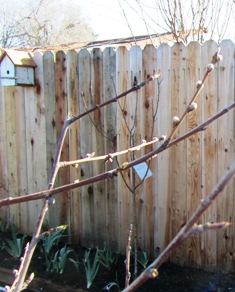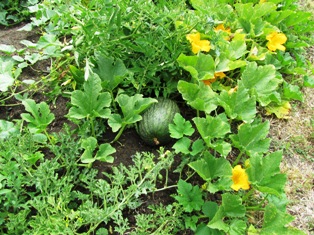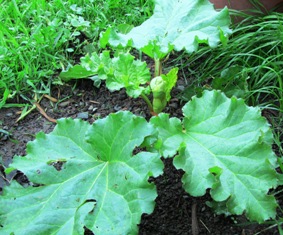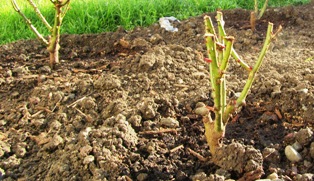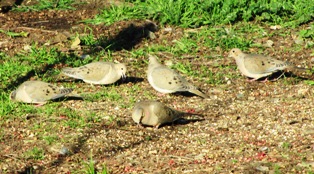Archive for the 'Plants and Trees' Category
Growing Palate-Pleasing Peaches
In the orchard area of the Henny Penny Farmette, we’ve planted several fruiting peach trees. Today, during this first full week in February, the Desert Gold peach trees (Prunus persica) broke into bloom.
These trees are more tolerant of heat than some of the varieties, but if planted in the desert Southwest or even in the hot interior valleys of California, the peach trees will perform better if given a little afternoon shade.
There are basically four types of peach trees: fruiting, flowering, combination fruiting and flowering, and dwarf. All peaches require heat during the hot weather months of their growing cycle and won’t properly set many blooms or be well pollinated during springs that are cold and wet. These trees also need some chilling during the winter months when they drop their leaves and go dormant.
We’ve discovered that our peach trees benefit from regular feedings (I’ve used fish emulsion tea, manure tea, and even chicken manure worked into the soil around the base of the tree) two or three times a year. For mature trees, plan on cutting away 2/3 of the previous year’s growth or cut each branch back about 1/3 it’s total length.
The Internet has some great videos that demonstrate how to properly prune your peach trees.
If you’ve prune your peach tree properly, you’ll have lovely, large fruits. Another technique to increase fruit size is to thin the number of fruits on the tree. Taking away some of the smaller fruits and reducing the size of the crop means that the remaining fruit can enlarge before ripening.
Peach leaf curl, peach leaf borer, and scale insects are pesky problems for peach growers and gardeners. Treatment requires spraying with Bordeaux mixture or lime sulfur twice a year. Nurseries suggests you spray your peach trees in November and again just before the buds swell.
Now, our trees are ready to flower, be pollinated by the honeybees, and produce some luscious peaches by the end of May. I’ll use the ripe peaches to make some palate-pleasing jams.
Three Ways to Propagate Hydrangeas
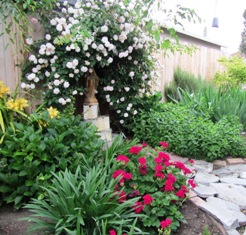
The hydrangea shrub, on left below the golden blooms of an orchid, add interest to a corner of the garden
Hydrangeas, deciduous shrubs indigenous to southeast Asia, bloom from summer to fall. Although the shrubs lose their leaves in winter, showy large pink, white, red, and sometimes blue blooms adorn the plant in summer.
They are easy to grow if you have rich, porous soil, but do need adequate watering (even misting in hot summer weather). Plant them where they can get morning sun but are shaded in the afternoon. They tend to wilt if they get too hot and dry.
There are basically three ways to propagate these beautiful plants that reward gardeners with big flower clusters. You can root cuttings from a branch of the bush, in water, or in a pot.
To root a cutting from a branch of a live plant, simply select a low branch and make sure it touches the soil. Anchor it to the soil with a stone or brick. Leave it there until it roots. Once it has roots, cut the branch from the bush. Dig up the newly rooted branch, taking care not to disturb the delicate, new roots. Transplant into a location of morning sun, afternoon shade. Give it ample water.
Or, take a cutting from the mother plant, put it into a vase or glass jar of water, place the jar where it will get indirect light, and wait until it roots. Change the water often to prevent mold from growing. Transplant when the cutting has formed roots.
Finally, you can also take a cutting from the mother plant to root to root in a container of potting soil and sand or vermiculite mixed in a ratio of 1:1. Gently water the soil to ensure no dry spots are present. Remove the cutting from the mother plant, snipping away all but the top leaves from the cutting. Dip the cut end into root hormone. Stick the cutting about two inches into the prepared container of soil. Do not let the soil dry out but don’t over water. Roots will take about two to three weeks for form.
Plants for a Songbird Garden
If you enjoy songbirds as I do, you might want to plant a garden of flower and herb varieties to attract them.
Include in your songbird garden some perennials and annual plants. The perennials will re-seed themselves or return year after year. Commercial seed companies offer a pre-packaged collection of seeds, but you can also gather your seeds or plants from other sources such as friends, neighbors, and garden club members. I save the seed from many of my plants, dry them, and use them for planting the next year.
Plants might include (but are not limited to) Alcea rosea (common hollyhock, comes in many colors), Amaranthus caudatus (commonly known as love-lies-bleeding), Carthamus tinctoria (safflower seed), coreopsis (tickseed), Cosmos bipinnatas (old flower garden favorite), Delphinium ajacus (blue or purple larkspur), Echinacea purpurea (eastern purple coneflower), Eschscholzia California (California poppy), Guizotia abyssinica (Nyjer seed, often called thistle although it isn’t thistle by an oily seed loved by finches), Panicum miliaceum (common millet), Papaver rhoeas (opium poppy, some types can be as tall as seven feet), and Rudbeckia hirta (Black-eyed Susan).
The heights of these various plants range from about 15 inches to six or seven feet. The colors are varied, ranging from whites to pink, red, orange, yellow, green, and blue.
The types of songbirds these plants will attract include cardinals, finches, goldfinches, hummingbirds, mockingbirds, warblers, chickadees, wrens, titmice, and thrushes.
The Cornell Baking Soda Formula for Roses
While perusing the December 2012 edition of American Rose, the Magazine of the American Rose Society, I discovered an article about the diseases of roses and some of the ways several rose experts would deal with them.
In a discussion of treating rust, downey mildew, and blackspot, the rose experts concurred that prevention is the first line of defense against these diseases. Once you find evidence of them in your garden, you must remove and destroy infected leaves and stems, including the leaves that have fallen to the ground.
Another important step, among others, was to spray an oil and bicarbonate of soda recipe referred to as the Cornell Baking Soda Formula.
The ingredients are simple and can be found in many homes: 1 Tablespoon each of baking soda, horticultural or summer oil, and castille soap. Mix these into 1 gallon of water, shake, and spray.
For advice on growing roses that are best suited to your area, check with your local nurseries and consider joining your the American rose society or local garden club. Also, think about choosing varieties of roses to grow in your area that are resistant to these diseases.
Planning and Planting a Perfumed White Garden
Some years ago while researching a book about decorating with flowers and floral motifs, I learned about the white garden of English writer Vita Sackville-West. The garden was part of her Sissinghurst estate in Kent, England. I seized upon the idea of someday having my own white garden.
Sackville-West’s garden, planted roughly from 1949 to 1950 featured various plants with white flowers and others with gray-green foliage. The combination of white and gray-green colors is stunning when viewed by moonlight. The author sought not only ravishing florals such as Regale lilies and trumpet lilies, dianthus, and white peonies but also made certain that her chosen flowers would perfume the garden.
On my Henny Penny farmette, I’ve created a fairy ring in a white garden that I’ve started. The center of the fairy ring is an Iceberg hybrid tea rose. I used artemisia (Dusty Miller) with silvery gray-green leaves planted in a circle around the rose. I frequently have to aggressively clip the artemisia as its feathery leaves grow fairly fast.
In another area, I have also planted a group of floribunda white roses and plan to put in white mugwort. Other plants with white blooms will be added and then the whole area encircled in yarrow. A piece of statuary, perhaps a four or five foot angel, will be installed to finish the project.
Other white flowering plants I could tuck into a white garden could include tuberose, phlox, Madonna lily, evening stock, cleome, and various white roses. Those plants are also highly fragrant.
A perfect place to position a white perfumed garden might be beyond a bedroom window. You could see it in the moonlight and breathe in the heady perfume as you are falling asleep.
Seasonal and Perennial Vegetables
To get your vegetable garden off to a great start, know whether you are planting a cool season- or warm-season plant. Get your veggies into the soil at the right time for optimum results. For warm–season vegetables such as beans, corn, cucumber, eggplant, melons, peppers, squash, and tomatoes, plant as soon as the soil is workable, when frost danger has passed.
Sow seeds directly into the soil or plant seedlings that you’ve started in flats indoors or that you buy at the nursery. The warm-season vegetables will grow and crops often will be ready to harvest before the blazing heat of mid-summer sets in.
Cool-season plants include asparagus, broad bean, beet, broccoli, brussels sprouts, cabbage, carrot, cauliflower, endive, garlic, leek, lettuce, parsnip, pea, radish, and turnip. These can go into the earth mid-summer so the growth spurt to maturation takes place during the fall. Crops can be harvested in the autumn or early spring.
Most vegetable are annuals, but a few are perennial plants, including artichoke, asparagus, chayote, and rhubarb.
Rhubarb is a vegetable, but is often used like a fruit (for example, with strawberries) in a sauce or pie. Plant rhubarb in early spring or late winter. Don’t plan on harvesting stalks until the third spring (giving the plant two complete growing cycles). When harvesting, discard the leaves as they are poisonous.
Asparagus is another plant that needs about three growing cycles, but then will reward with spears for a dozen or more years in the garden. The green feathery top growth is a lovely but when it turns brown in the fall, it needs to be cut to soil level.
Artichokes need a lot of garden space as they grow to about 4 feet high and can double that size in width. Artichokes grown in coastal California, are harvested from September to May. They are the flower buds found at the top of large stalks. The perennial artichoke will need to have the tops cut to about a foot in the fall and folded over the top of the root. The plant then needs heavy mulching to protect it during cold weather.
Chayote is a relative of squash and produces edible fruits along a climbing vine. Plant this perennial in February or March (after the frost danger has passed) near a fence or on a trellis. When you tuck this plant into your garden, be sure to put the sprouted end at the lowest level in the soil, leaving the narrow end exposed. Expect 20 to 30 feet or more of vine.
Before you head off to the nursery to buy plants, consider starting some seeds indoors. Not only will you find it to be economical, you’ll also get a jump on the growing season.
Grow plants from open-pollinated seed. You can then harvest some of the seeds to use again next year. Hybridized seed won’t come true the second year, but open-pollinated seeds will produce plants just like the parent plant.
Outdoor Projects on the Farmette
During winter when rain is frequent and freezing nights seem more common than they used to be in Northern California, we permit the land to rest. This season is perfect for reviewing our master plan for the property and the outdoor projects ahead of us.
We still have work to do on our house but we are thinking of outdoor entertaining spaces, too.
We get great ideas while visiting local nurseries and do-it-yourself supply centers, but we resist the temptation to start any new outdoor project until the weather has warmed. Also we don’t plant shrubs, roses, or trees in the garden without considering how doing so might impact our overall garden design.
The exception is heeling in a bare-root plant. That means we put a plant into a temporary hole in the ground to keep the roots from drying out before moving it to its permanent location. We don’t want our plants to break dormancy too soon because a frosty night could damage new plant growth.
While we stroll around the property, we discuss landscape plans for this new year. Frequently, we stop to watch the birds feeding and squirrels foraging. We talk about which area of the farmette might be the best location for a house expansion, utility shed, or outdoor kitchen.
Carlos has a strong aesthetic sense about design. He’s created some lovely outdoor kitchens. Since he takes into consideration the environment as well as functionality in his designs, he’s already thinking about building sites on our property that capitalize on the various views we have of Mt. Diablo but that are not too far away from the house.
Just listening to Carlos talk about his design ideas inspires me to think about grilling in the to-be-built outdoor kitchen, perhaps fresh figs and melted goat cheese or oysters (with garlic butter, shallots, and fresh Parmesan). We love sharing food with friends and neighbors in an outdoor spaces during nice weather, but for now our small patio will have to suffice.
We keep chipping away at what needs to be done, finishing one thing , crossing it off the list, and moving on to the next. The outdoor kitchen is pretty far down on a long list of things to do. But as the old adage goes: Hope springs eternal.
Managing Rose Rust
I found rust on the undersides of leaves on some of my hybrid tea and floribunda roses while strolling around the farmette this morning. Usually by this time of year I have plucked off all the old leaves and cut the canes down to between 12 and 18 inches. The cutting back of hybrid teas and floribundas is necessary since those rose bushes produce flowers on new growth. Removing the leaves and cutting out the dead wood as well as pruning back the canes this time of year (end of December) encourages dormancy. I’m just now getting around to doing these chores.
Removing the foliage and destroying disease-infected leaves is a must. Do not put these in your compost pile. I keep a little bag next to me when I’m working with the roses in case I find evidence of rust or powdery mildew or black spot. Wind, rain, and overhead watering can spread the spores of these diseases. Destroying the leaves ensures that the plant gets a new start in the spring and that diseases cannot winter over on the foliage.
Rust most often appears on roses when the plant has moisture on its leaves for several hours. The rust infection looks like orange or yellow spots on the underside of the leaf. Eventually, it can migrate to the topside of the leaf as well. Leaves infected with rust will discolor and drop to the ground.
The long term solution to dealing with rust is to use drip irrigation or a soaker and to avoid overhead watering of your roses. As soon as you noticed rust, black spot, or mildew, remove and destroy any infected leaves and stems. Clean beneath the base of each plant and mulch with organic materials. That way, come spring your rose can start anew, producing strong canes, healthy leaves, and gorgeous blooms.
Plants for Sun Rooms, Solariums, and Conservatories
My husband and I grew exotic flowers in and around our Miami, Florida home. We had a sun room that sheltered a swimming pool in which I swam laps in every day. The space seemed near perfect for growing orchids in cycles of perpetual bloom. They loved loved the heat, light, and moisture provided by the pool and a fountain we installed. We also had an angel trumpet tree (Datura arborea) in the front of the house, adding drama and a luscious scent to the entry area.
But with the freezing winter temperatures on our Northern California farmette, such plants would not survive unless grown in a conservatory type of room with lots of warmth and light.
Since buying the farmette, my hubby and I have toyed with the idea of building such a space, also known as sun room, greenhouse room, tea room, and solarium.
A major consideration besides money and materials would be the direction the room would face. For our farmhouse, the direction (also known as “aspect”) could be north where the patio is already located or if positioned at the front of the house (where we had planned to create a wraparound front porch), the sun room or conservatory’s aspect would face south.
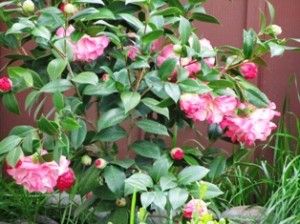
This Camellia japonica produces attractive blooms in early to mid spring and would do well in a cooler sun room
A north-facing aspect permits plenty of light but less heat. In a cooler conservatory or sun room, we’d use more foliage plants such as camellia, begonia, geranium, anthurium, Australian bottle brush, fuchsia, ficus, gardenia, campanula, hypoestes , and various types of ivy and palm. We could also grow Cymbidium orchids that like dappled shade during summer but bloom in the dead of winter.
A south or west direction ensures intense light and heat and would allow us to grow more flowering plants (especially ones found in the subtropics and tropics), including exotic orchids.
My husband grew up on a Caribbean island and loves orchids. The cymbidium orchids do well enough already outside. We put them in protected areas on frosty nights. But many of the exotic orchids require light, heat, and, in some cases, additional moisture.
We know Phalaenopsis, odontoglossum, and slipper orchids would thrive in a conservatory room that faces south or west as would many other plants such as hibiscus, jasmine, nephrolepsis, passion flower, plumeria, and African violet, to name a few. Also, many hybrid rhododendrons that profusely flower for long periods can be grown in containers in a warm environment.
I’m really an outside garden girl, but a conservatory room with a lot of interesting architectural detail and gorgeous blooming plants could make me want to spend more time indoors. It doesn’t matter to me whether it faces north or south. But dare I bring up the idea of adding a pool?
Herbs for Healing and Well-Being
For thousands of years, humankind has relied on the healing properties of herbs, plucked in the wild or cultivated in gardens, to treat what has ailed them. Modern holistic practitioners value herbs and plant-based medicines as integral elements in re-balancing the health of their patients and fostering wellness and robust vitality.
Doctors trained in allopathic or mainstream Western medicine traditionally have prescribed chemically based medicines (that usually have side effects). However, Western-trained doctors may also recommend the use of herbs for certain health issues. Always talk with your physician before starting any type of self-treatment with herbs. Keep your physician informed of herbs you may be taking. Herbs or herb formulations can interact or even block the efficacious effect of the medications your doctor has prescribed.
Dr. Andrew Weil, the Harvard-trained physician who pioneered the field of integrative medicine (combining mainstream and alternative medicine) and also wrote several best-selling books, suggests three specific herbs can reduce inflammation in the body–tumeric, ginger, and boswellia. These herbs can be found in specific doses formulated in capsules to make it easy to take the right amount. See, http://www.drweil.com/drw/u/QAA142972/Anti-Inflammatory-Herbs.com.
In traditional Chinese medicine, four herbs play vital roles in achieving a state of well-being. Rosemary stimulates brain alertness, mint aids in digestion, sage supports mental acuity, and parsley protects the eyes. See, http://www.doctoroz.com/blog/mao-shing-ni-lac-dom-phd/4-commonly-used-healing-herbs.
Whether herbs are used dried or fresh, made into a tea, tincture, culinary preparation, or packaged in capsules and other forms, they are often included as part of a larger health-focused program to restore and maintain a balanced, healthy body.
Ayurveda, a healing system used in India since ancient times, utilizes herbs in treatments that can encompass many healing modalities. According to Ayurveda, a balanced, healthy body depends on a strong metabolic and immune system, attained through proper nutrition, exercise, yoga, and meditation (to relieve tension and stress that can accumulate in the body and mind).
Herbs used in Ayurveda are many and include (but are not limited to) andrographis, ashwagandha, black mustard seed, cardamom, coriander, cumin, ginger, purslane (pigweed), tulsi (holy basil), tumeric, and visnaga.
During the medieval period, gardens of priests, convents, and cloisters contained the herbs that members of the clergy as well as ordinary people believed could treat or cure them of their ailments. In the twelfth century, German mystic Saint Hildegard of Bingen wrote about health and healing, detailing medicinal uses of over 200 healing plants.
Although most herbs are fairly easy to grow, take the time to learn about them. Provide for the plant’s needs (water, nutrients, sun or shade requirement). Find out when to harvest and how best to use the plant for your health and well-being. Find out what the negative factors might be in using a specific herb or medicinal plant. When you engage in this type of work, you continue a practice begun thousands of years ago that can have health benefits for you today. But don’t forget to have that discussion with your doctor before taking medicinal herbs.
 Facebook
Facebook Goodreads
Goodreads LinkedIn
LinkedIn Meera Lester
Meera Lester Twitter
Twitter





